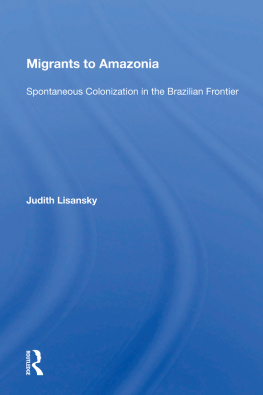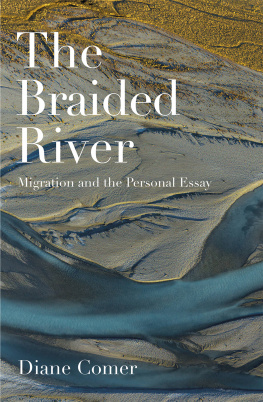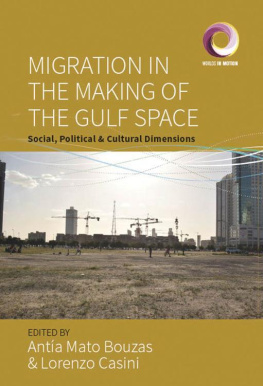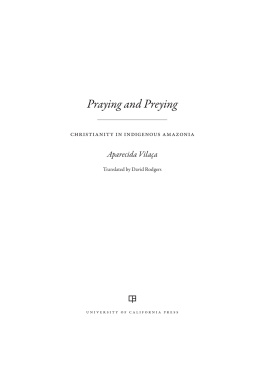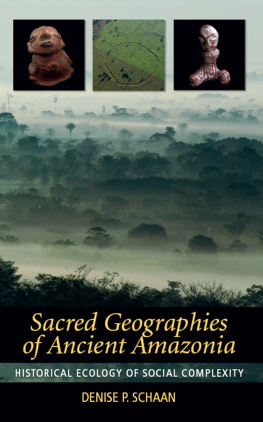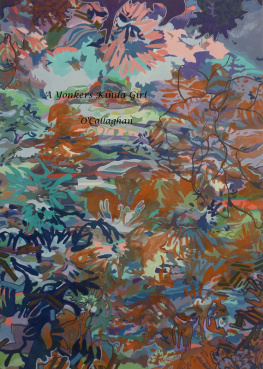Migrants to Amazonia
Published in cooperation with the Amazon Research and Training Program Center for Latin American Studies University of Florida
Migrants to Amazonia
Spontaneous Colonization in the Brazilian Frontier
Judith Lisansky
Foreword by Charles Wagley
First published 1990 by Westview Press
All photos, including the cover photo, were taken by the author.
Published 2018 by Routledge
52 Vanderbilt Avenue, New York, NY 10017
2 Park Square, Milton Park, Abingdon, Oxon OX14 4RN
Routledge is an imprint of the Taylor & Francis Group, an informa business
Copyright 1990 by Taylor & Francis
All rights reserved. No part of this book may be reprinted or reproduced or utilised in any form or by any electronic, mechanical, or other means, now known or hereafter invented, including photocopying and recording, or in any information storage or retrieval system, without permission in writing from the publishers.
Notice:
Product or corporate names may be trademarks or registered trademarks, and are used only for identification and explanation without intent to infringe.
Library of Congress Cataloging in Publication Data
Lisansky, Judith Matilda, 1950-Migrants
to Amazonia: spontaneous colonization in the Brazilian
frontier / Judith Lisansky; foreword by Charles Wagley.
p. cm.(Westview special studies on Latin America and the
Caribbean)
"Published in cooperation with the Center for Latin American
Studies, University of Florida"Prelim. leaf.
Includes bibliographical references.
ISBN 0-8133-7495-2
1. Santa Teresinha Region (Mato Grosso, Brazil)Economic
conditions. 2. Santa Teresinha Region (Mato Grosso, Brazil)
Population. 3. Land settlementBrazilSanta Teresinha Region
(Mato Grosso) 4. Land tenureBrazilSanta Teresinha Region (Mato
Grosso) 5. Migration, InternalBrazil. I. Series.
HC189.S26L57 1990
304.8'811dc20 89-37518
CIP
ISBN 13: 978-0-367-01431-5 (hbk)
This book is dedicated with love to the two women who made it possible: my mother, Edith Silverglied Lisansky Gomberg, and my inspiring friend, Marisbela Vaitsman
| Tables |
| Figures |
| Brazil in its regional setting |
| Photos |
In 1939, when I first descended the Araguaia River by canoe en route to the Tapirap Indians, I saw a small white chapel surrounded by perhaps four or five houses on a hill back from the river. I did not stop, for the back woodsmen who were my guides told me that Furo de Pedra was only "3 leagues" (9 kilometers) downriver. It was at Furo de Pedra that I was to meet my fellow anthropologist, William Lipkind; and it was there that I made my Araguaia River headquarters. There I was told that the chapel and the four houses were collectively called "Mouro de Areia" (Hill of Sand)"a sad place to live." Both Furo de Pedra and Mouro de Areia were totally isolated settlements. They were about 600 kilometers from Leopoldina (now called "Arawana"), where a primitive motor road gave access to Goiaz, the former capital of the state by that name; and it was about the same distance to Conceio do Araguaiaa somewhat larger Brazilian settlement downriver, where riverboats provided occasional transportation to Belm at the mouth of the Amazon. Once a month, more or less, a small river boat ironically called the "Araguaia Express" plied between Leopoldina and Conceo, and every month two canoemen brought mail from Leopoldina to settlers along the same stretches of the river. The Araguaia River flowed through true serto (back country), an area little explored and populated by Indians and a few subsistence farmers. In 1939 and 1940 I passed by Mouro de Areia several times on my trips to and from Furo de Pedra and the Tapirap village up the Tapirap River, an affluent of the Araguaia. I never stopped. There seemed little or nothing of interest.
In 1953, when I returned by airplane to visit the Tapirap, who had moved their village downriver to the margins of the Araguaia, I landed at an airstrip at Santa Terezinha. I quickly recognized the small town as old Mouro de Areia. I was told that Furo de Pedra was being abandoned because of annual floods and that the people had moved to Santa Terezinha. A So Paulo corporation (probably CODEARA) had begun clearing forest back from the river. The company had opened the airstrip at Santa Terezinha and had persuaded a commercial airline to stop there once a week. There were more houses now, a small pens o for lodging company officials and technicians, and a general store. I met many of my old friends, who were refugees from Furo de Pedra.
In 1957 and again in 1965, I briefly visited Santa Terezinhaeach time en route to the Tapirap, whose village was situated some 30 kilometers upriver. The small town had grown rapidly. I heard considerable talk about Santa Terezinha and its problems during the time I resided in the Tapirap Indian village. Padre Franois Jentel, the French worker priest who had settled with the Tapirap, and the French missionary nuns (the Little Sisters of Jesus), traveled frequently to Santa Terezinha. These missionaries had extended their activities to the Brazilian peasant population of Santa Terezinha. On Sundays Padre Jentel celebrated mass in the chapel, which was now a church. He was organizing a cooperative among the small farmers and a small health clinic. The Little Sisters established a school and operated the health clinic. I learned that "the Company"the ranching corporationhad claimed all of the surrounding lands, even the town of Santa Terezinha itself. The missionaries were appalled by the conditions imposed on the laborers contracted to clear the land for grazing, by the eviction of local people from land they occupied without title, and by the situation of migrants attracted to the area seeking land and work. Padre Jentel told me of unrest among the people of Santa Terezinha, adding that he feared violence. In 1972 violence did erupt in a gun battle between the displaced caboclos (back woodsmen) and "the Company." The federal government intervened by sending troops. The sad story of Padre Jentel, who was charged with subversion, imprisoned, and expulsed from Brazil, is related in this book (see also Davis 1977). The resulting publicity did, however, force the Brazilian government to some action. The ranching company was forced to concede some land to long-term residents and to the town of Santa Terezinha itself.
In 1978-1979, when Judith Lisansky carried out her research for this study of Santa Terezinha, the social and economic problems of Santa Terezinha had not been solved. Other ranching companies had been attracted to the area. The small town had grown to about 2,000 people. It had become a distrito (subdistrict) of the enormous munic pio (municipality) of Luciara, the seat of which is situated about 70 kilometers upriver. Migrants from northeastern Brazil, looking for work and/or land, continued to be attracted to the area; frustrated, they often moved after months, weeks, even days. People with land also continued to be evicted. The military government of Brazil had put down violence, but it had not solved the problems that produced violence. It was not a community in which an anthropologist could easily do field work. Nothing seemed stable, even for a short time. One's friends of today might be gone tomorrow. Santa Terezinha exhibits many of the characteristics of a "wild west" frontier town of the mid-nineteenth-century United States. Judith Lisansky is to be congratulated for her study, undertaken in very difficult circumstances.

